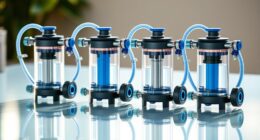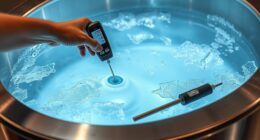To maintain effective post-session recovery routines, focus on immediately applying cold or heat therapy, rehydrating with electrolyte-rich drinks, and consuming nutrient-dense foods to support muscle repair. Incorporate gentle stretches, active recovery, and quality sleep to help your body fully reset. Tracking your progress helps identify what works best and makes it easier to adjust routines over time. Keep exploring these strategies to optimize your recovery process and achieve better results.
Key Takeaways
- Implement immediate post-activity techniques like cold & heat therapy to reduce inflammation and promote blood flow.
- Prioritize hydration with electrolyte-rich drinks within 30 minutes to replenish minerals and prevent cramps.
- Consume nutrient-dense foods and incorporate stretching, foam rolling, and quality sleep for optimal muscle repair.
- Use active recovery methods such as gentle movement and massage to enhance circulation and reduce soreness.
- Monitor recovery metrics like heart rate and soreness to adjust routines and prevent overtraining.
Understanding the Importance of Post-Session Recovery

Understanding the significance of post-session recovery is essential for maximizing your training results and preventing injury. When you prioritize recovery, you give your body and mind the chance to reset, reducing stress and mental fatigue. Mental relaxation after workouts helps clear your mind, preventing burnout and enhancing focus for future sessions. Recovery also plays a critical role in injury prevention by allowing your muscles, joints, and connective tissues to repair and strengthen. Incorporating practices like meditation can further support mental clarity and emotional stability during recovery. Skipping recovery can lead to overtraining, increased soreness, and higher injury risk. By incorporating intentional rest and relaxation routines, you support your overall progress and long-term performance. Remember, recovery isn’t just about physical healing; it’s also about restoring mental clarity, so you stay motivated, balanced, and injury-free.
Hydration Strategies to Replenish and Rejuvenate

Choosing the right fluids at the right time can make all the difference in your recovery. Prioritizing electrolyte-rich drinks and knowing when to hydrate guarantees your body recharges effectively. Mastering these strategies helps you feel rejuvenated faster and ready for your next session. Incorporating proper hydration routines can also help prevent market volatility from impacting your recovery process.
Optimal Fluid Choices
After a demanding session, replenishing lost fluids is essential for recovery, but not all drinks are equal. Your goal is to choose fluids that enhance hydration timing and support electrolyte balance. Water is crucial, but adding electrolyte-rich drinks helps replace sodium, potassium, and magnesium lost through sweat. Look for options that contain a balanced mix of electrolytes without excess sugars or artificial ingredients. Coconut water naturally offers electrolytes and is a good natural choice. Avoid drinks high in sugar, which can lead to dehydration or energy crashes. The key is to select fluids that hydrate efficiently and restore electrolyte levels, setting the stage for effective recovery. Proper stove safety measures, such as selecting safe hydration options, help maintain overall health and performance. Prioritizing these choices helps you bounce back faster and maintain ideal performance.
Timing Matters Most
Timing is critical when it comes to hydration; drinking fluids at the right moments can substantially enhance recovery. Precise timing guarantees your body rehydrates efficiently, supporting recovery scheduling and reducing fatigue. The key is to act swiftly—preferably within 30 minutes post-session—to optimize fluid absorption. Incorporating hydration strategies during this window can further maximize your recovery efforts. Imagine:
- You sip water immediately after finishing, preventing dehydration.
- You gradually increase intake, matching your sweat loss.
- You avoid waiting too long, which delays recovery.
- You monitor your thirst cues, ensuring you’re not under- or over-hydrating.
Electrolyte Replenishment
Electrolyte replenishment is essential for effective recovery because it restores the minerals lost through sweating during your session. Maintaining electrolyte balance helps prevent muscle cramps, fatigue, and dehydration, ensuring your body recovers efficiently. To achieve this, mineral supplementation is key—consider drinking electrolyte-rich beverages or adding mineral supplements to your post-workout routine. Focus on replenishing sodium, potassium, magnesium, and calcium, which are critical for nerve function and muscle recovery. Proper hydration combined with electrolyte intake supports ideal fluid absorption and reduces recovery time. Don’t rely solely on water; incorporate electrolytes to fully restore your mineral levels. This targeted approach helps your body rebound faster, keeps your energy levels stable, and prepares you for your next session with renewed vitality. Incorporating best electrolytes for keto diet options can further optimize your recovery and maintain ketosis.
The Role of Nutrition in Recovery and Muscle Repair

Nutrition plays a vital role in speeding up recovery and repairing muscle tissue after intense sessions. Proper nutrient intake stimulates protein synthesis, essential for muscle repair and growth. Focus on nutrient timing—consuming the right nutrients within the optimal window—maximizes recovery. You might imagine:
- A colorful plate of lean proteins, like chicken or fish, fueling muscle repair.
- A handful of berries or a banana providing quick carbs to replenish glycogen.
- Hydrating with water and electrolyte-rich drinks to support cellular function.
- Timing your post-workout meal or shake to enhance nutrient absorption and protein synthesis.
- Utilizing air purifiers to maintain a clean environment that promotes better sleep and overall recovery.
Effective Stretching and Mobility Exercises

After fueling your muscles with proper nutrients, focusing on effective stretching and mobility exercises can optimize your recovery and prepare your body for future workouts. Dynamic stretching is key—you move through controlled, purposeful motions that increase blood flow and loosen tight muscles. Incorporate movements like leg swings or arm circles before your session to improve flexibility and range of motion. Foam rolling is also essential; it breaks down fascia restrictions, reduces soreness, and enhances tissue elasticity. Spend a few minutes rolling major muscle groups, especially those you’ve heavily worked. These routines promote circulation, reduce stiffness, and accelerate recovery, making them crucial post-session practices. Consistently integrating dynamic stretching and foam rolling ensures your muscles stay healthy, resilient, and ready for your next challenge.
Rest and Sleep: Foundations of Optimal Recovery

Getting enough quality rest and sleep is essential for your body’s recovery process. Good sleep hygiene creates a stable environment for restorative rest, helping you fall asleep faster and stay asleep longer. During deep sleep stages, your body repairs tissues, boosts immune function, and consolidates memory through dream analysis. Establish a consistent bedtime, limit screen time before bed, and keep your sleeping area cool and dark. Avoid caffeine and heavy meals late in the evening to prevent disruptions. Visualize your dreams as a window into your subconscious, guiding you toward better stress management. Prioritizing sleep ensures your muscles recover efficiently and your mind recharges, setting a strong foundation for ideal recovery after each session. Incorporating relaxation techniques such as meditation or deep breathing exercises can further enhance your sleep quality and overall recovery.
Using Cold and Heat Therapy for Inflammation Reduction

Building on the importance of quality rest, applying cold and heat therapy can considerably speed up your body’s inflammation reduction process. Cold compression helps reduce swelling and numbs pain by constricting blood vessels, making it ideal immediately after intense activity. Use ice packs or cold compresses on sore areas for 15-20 minutes to minimize inflammation. Heat therapy, on the other hand, promotes blood flow, relaxing muscles and easing stiffness. Applying a warm towel or heating pad for 15-20 minutes encourages circulation and accelerates healing. Alternating between cold compression and heat therapy can optimize recovery, reduce soreness, and prevent lingering inflammation. Just make sure you don’t apply heat directly to inflamed skin, and always listen to your body’s signals to avoid overstimulation. Incorporating water therapy techniques can further enhance your recovery routine by improving circulation and reducing muscle tension.
Incorporating Active Recovery Techniques

Incorporating active recovery techniques into your post-session routine can substantially enhance your body’s ability to heal and reduce soreness. Moving gently helps flush out lactic acid, promotes circulation, and prevents stiffness. Use recovery gadgets like foam rollers or massage guns to target tight muscles effectively. Incorporate light activities such as walking, swimming, or cycling to keep blood flowing without overexerting yourself. Experiment with massage techniques—whether self-massage or professional—to ease knots and improve flexibility. Visualize yourself rolling out sore areas, leisurely strolling in the park, or using a massage gun to release tension. Engaging in proper recovery strategies can also help prevent injuries and improve overall workout performance. These practices keep your muscles active, accelerate recovery, and prepare you for your next session with less discomfort and more mobility.
Tracking Progress and Adjusting Your Routine

To improve your recovery routine, you need to track key recovery metrics like sleep quality, soreness levels, and energy after sessions. Use this data to identify patterns and see what’s working or needs adjustment. Then, adapt your routine accordingly to keep progressing and prevent setbacks. Incorporating passive voice detection into your editing process can further enhance clarity and effectiveness.
Monitoring Recovery Metrics
Monitoring your recovery metrics is essential because it helps you understand how well your routine is working and where adjustments are needed. By focusing on biomarker analysis and tracking your heart rate, you gain insights into your body’s response post-session. Look for patterns that indicate recovery progress or signs of fatigue.
Consider these key indicators:
- Fluctuations in resting heart rate over days
- Changes in biomarker levels like cortisol or lactate
- Consistency in heart rate recovery times
- Variations in subjective fatigue scores
Tracking these metrics allows you to fine-tune your recovery routine, ensuring you’re not overtraining or under-recovering. Staying attentive to these signs keeps your routine effective, helping you optimize performance and avoid setbacks.
Routine Adaptation Strategies
Tracking your progress is essential because it allows you to identify patterns and determine whether your recovery routines are effective. Pay attention to how your body responds over time, using mindful breathing to stay present and aware during your recovery. Incorporate mental visualization to imagine your ideal recovery state, which helps you recognize what’s working and what needs adjustment. If you notice persistent fatigue or soreness, consider tweaking your post-session routines—perhaps adding more stretching or rest. Regularly reviewing your progress enables you to adapt your strategies proactively, ensuring recovery remains effective and sustainable. By staying mindful and visualizing success, you create a feedback loop that keeps your routines aligned with your evolving needs. Adaptation is key to maintaining excellent recovery.
Frequently Asked Questions
How Often Should I Update My Recovery Routine?
You should update your recovery routine every few months or when your training intensity changes. Incorporate new strategies like improved nutrition planning and better sleep hygiene to optimize recovery. Regular updates guarantee your routine stays effective and tailored to your evolving needs. Listen to your body, and if you notice signs of fatigue or stagnation, tweak your recovery methods promptly to keep progress steady and avoid burnout.
Can Recovery Routines Prevent Future Injuries?
Absolutely, a solid recovery routine can be your superhero against future injuries! By incorporating muscle relaxation techniques and hydration strategies, you fortify your body’s defenses, making injuries less likely. Regularly updating and sticking to these routines helps your muscles recover faster and stay resilient. Think of it as armor for your body—preventing strains and tears before they even happen, so you can stay in the game longer and stronger.
What Signs Indicate I Need Professional Recovery Assistance?
You should seek professional recovery assistance if you notice signs of overtraining like persistent fatigue, sore muscles, or declining performance. Mental fatigue indicators such as difficulty concentrating, irritability, or mood swings also signal it’s time to get expert help. Ignoring these signs can lead to injuries or burnout. Trust your body’s signals, and don’t hesitate to consult a specialist to develop a tailored recovery plan.
How Do Recovery Routines Differ for Various Sports?
Did you know that recovery routines vary widely across sports? For example, endurance athletes focus on hydration and active recovery, while strength athletes prioritize muscle repair with stretching and nutrition. Your routines should be tailored using training specificity and sport-specific strategies to optimize recovery. By customizing your post-session practices, you reduce injury risk and enhance performance, ensuring you bounce back faster and stronger for your next session.
Are There Common Mistakes to Avoid in Recovery Practices?
You should avoid common mistakes like stretching immediately after intense exercise, which can cause injury, and falling for hydration myths that suggest overhydration is always beneficial. Instead, focus on gentle stretching when your muscles are warm and drink water according to your body’s actual needs. Don’t rely on myths or rush recovery, as proper routines help your body recover faster and prevent setbacks.
Conclusion
Remember, consistent recovery routines keep you at your best. Prioritize hydration, proper nutrition, stretching, and rest to support your body’s healing process. Incorporate therapies like cold or heat treatment and stay active with gentle movements. Tracking your progress helps you make adjustments and avoid setbacks. As the saying goes, “A stitch in time saves nine.” Stay committed to your recovery, and you’ll see better results and fewer injuries in the long run.









